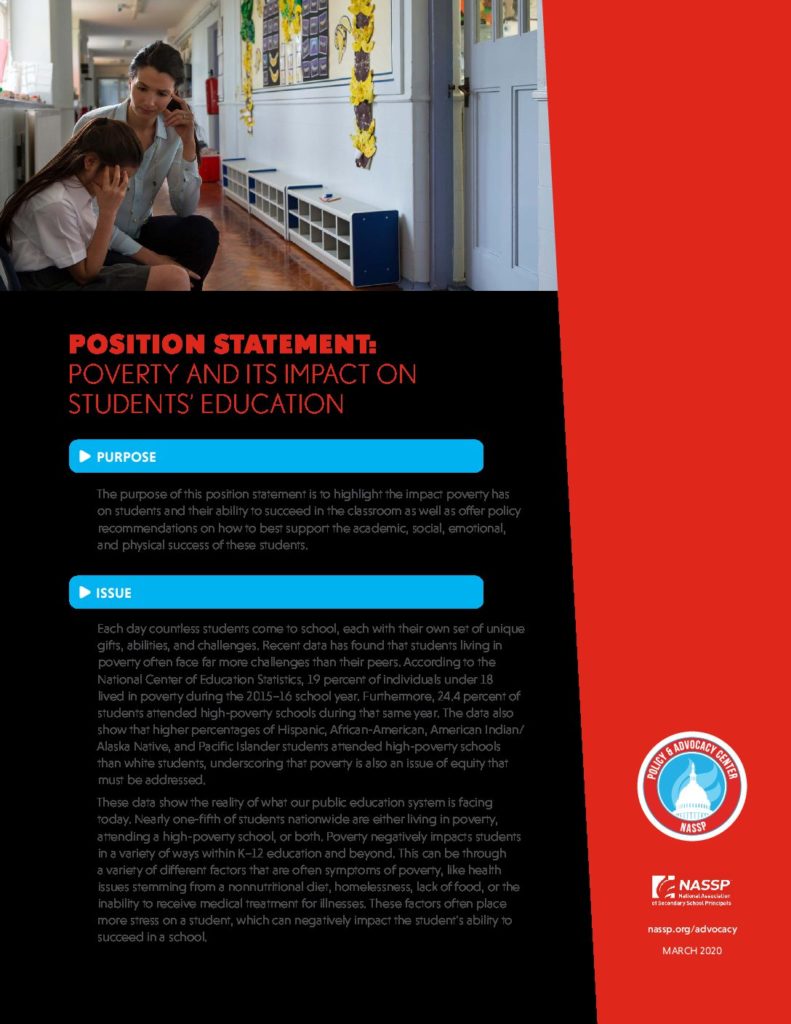
The purpose of this position statement is to highlight the impact poverty has on students and their ability to succeed in the classroom as well as offer policy recommendations on how to best support the academic, social, emotional, and physical success of these students.

Each day countless students come to school, each with their own set of unique gifts, abilities, and challenges. Recent data has found that students living in poverty often face far more challenges than their peers. According to the National Center of Education Statistics, 19 percent of individuals under 18 lived in poverty during the 2015–16 school year. Furthermore, 24.4 percent of students attended high-poverty schools during that same year. The data also show that higher percentages of Hispanic, African-American, American Indian/Alaska Native, and Pacific Islander students attended high-poverty schools than white students, underscoring that poverty is also an issue of equity that must be addressed.
These data show the reality of what our public education system is facing today. Nearly one-fifth of students nationwide are either living in poverty, attending a high-poverty school, or both. Poverty negatively impacts students in a variety of ways within K–12 education and beyond. This can be through a variety of different factors that are often symptoms of poverty, like health issues stemming from a nonnutritional diet, homelessness, lack of food, or the inability to receive medical treatment for illnesses. These factors often place more stress on a student, which can negatively impact the student’s ability to succeed in a school. Students living in poverty often have fewer resources at home to complete homework, study, or engage in activities that helps equip them for success during the school day. Many impoverished families lack access to computers, high-speed internet (three-fourths of households currently have access to high-speed broadband), and other materials that can aid a student outside of school. Parents of these families often work longer hours or multiple jobs, meaning they may not be available to assist their children with their schoolwork. Furthermore, in many high-poverty school districts, resources are sorely lacking in schools. Nearly every state has its own division of funding for school districts and education based on property taxes. Unfortunately, this system unfairly affects individuals living in poverty and the students attending school in those areas. Because property taxes are often much lower in high-poverty areas, schools in those areas receive much less than their more affluently-located counterparts. Recent data from the U.S. Department of Education state that 40 percent of high-poverty schools are not getting a fair share of state and local funds. This often leaves schools with limited budgets to address a multitude of issues, including hiring educators, updating resources for students, preparing students for postsecondary education or the workforce, dealing with unsafe infrastructure, and much more. There are often instructional gaps for those attending high-poverty schools as well. Data from the 2015–16 National Teacher and Principal Survey show that students from low-income families “are consistently, albeit modestly, more likely to be taught by lower-credentialed and novice teachers” (Garcia and Weiss). Research has also shown that many teachers in high-poverty schools are inexperienced and often less effective than their more experienced peers who are often targeted for hire by higher-income schools and districts. The lack of high-quality instruction serves to only further separate academic achievement levels for students in high-poverty schools from peers in high-income schools or districts.
Recommendations for Federal Policymakers
Recommendations for State Policymakers
Recommendations for District Leaders
Recommendations for School Leaders
Amerikaner, A., & Morgan, I. (2018, February 27). Funding gaps 2018: An analysis of school funding equity across the U.S. and within each state. Retrieved from https://edtrust.org/resource/funding-gaps-2018/.
Carr, S. (2013, February 26). The real reasons many low-income students don’t go to college. Retrieved from https://hechingerreport.org/the-real-reasons-many-low-income-students-dont-go-to-college/.
College for America. (2017, June 7). Addressing the college completion gap among low-income students. Retrieved from https://collegeforamerica.org/college-completion-low-income-students/.
Dynarski, M. (2017, March 1). It’s not nothing: The role of money in improving education. Retrieved from https://www.brookings.edu/research/its-not-nothing-the-role-of-money-in-improving-education/.
Garcia, E., & Weiss, E. (2019, March 26). The teacher shortage is real, large and growing, and worse than we thought: The first report in ‘The Perfect Storm in the Teacher Labor Market’ series. Retrieved from https://www.epi.org/publication/the-teacher-shortage-is-real-large-and-growing-and-worse-than-we-thought-the-first-report-in-the-perfect-storm-in-the-teacher-labor-market-series/.
Johnston, K. (2019, June 20). 7 ways poverty affects education. Retrieved from https://moneywise.com/a/ways-poverty-affects-education.
Jackson, K., Johnson, R., & Persico, C. (2016). The effects of school spending on education and economic outcomes: Evidence from school finance reforms. The Quarterly Journal of Economics 131(1), pp. 157–218.
LaFortune, J., Rothstein, J., & Schanzenbach, D.W. (2016). School Finance Reform and the Distribution of Student Achievement. National Bureau of Economic Research, Working Paper 22011, February 2016.
Martin, C., Boser, U., Benner, M., & Baffour, P. (2018, November 13). A quality approach to school funding. Center for American Progress. Retrieved from https://www.americanprogress.org/issues/education-k-12/reports/2018/11/13/460397/quality-approach-school-funding/
McFarland, J., Hussar, B., Wang, X., Zhang, J., Wang, K., Rathbun, A., Barmer, A., Forrest Cataldi, E., and Bullock Mann, F. (2018). The Condition of Education 2018 (NCES 2018-144). U.S. Department of Education. Washington, DC: National Center for Education Statistics. Retrieved from https://nces.ed.gov/pubs2018/2018144.pdf.
National Association of Secondary School Principals. (2019, March 19). Using PPE data to advocate for your school. School of Thought blog. Retrieved from http://blog.nassp.org/2019/03/22/using-ppe-data-to-advocate-for-your-school/.
Pascoe, M.C., Hetrick, S.E. & Parker., A.G. (2019). The impact of stress on students in secondary school and higher education. International Journal of Adolescence and Youth, DOI: 10.1080/02673843.2019.1596823.